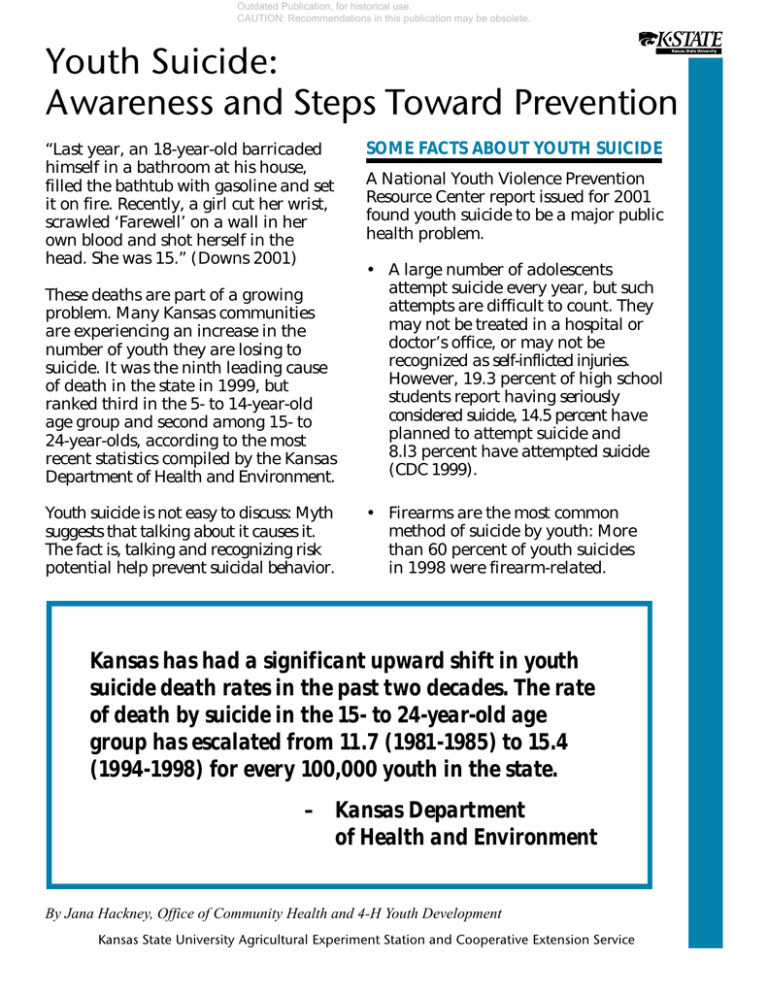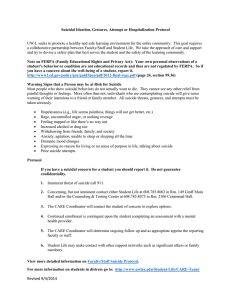
Outdated Publication, for historical use.
CAUTION: Recommendations in this publication may be obsolete.
Youth Suicide:
Awareness and Steps Toward Prevention
“Last year, an 18-year-old barricaded
himself in a bathroom at his house,
filled the bathtub with gasoline and set
it on fire. Recently, a girl cut her wrist,
scrawled ‘Farewell’ on a wall in her
own blood and shot herself in the
head. She was 15.” (Downs 2001)
SOME FACTS ABOUT YOUTH SUICIDE
A National Youth Violence Prevention
Resource Center report issued for 2001
found youth suicide to be a major public
health problem.
These deaths are part of a growing
problem. Many Kansas communities
are experiencing an increase in the
number of youth they are losing to
suicide. It was the ninth leading cause
of death in the state in 1999, but
ranked third in the 5- to 14-year-old
age group and second among 15- to
24-year-olds, according to the most
recent statistics compiled by the Kansas
Department of Health and Environment.
• A large number of adolescents
attempt suicide every year, but such
attempts are difficult to count. They
may not be treated in a hospital or
doctor’s office, or may not be
recognized as self-inflicted injuries.
However, 19.3 percent of high school
students report having seriously
considered suicide, 14.5 percent have
planned to attempt suicide and
8.l3 percent have attempted suicide
(CDC 1999).
Youth suicide is not easy to discuss: Myth
suggests that talking about it causes it.
The fact is, talking and recognizing risk
potential help prevent suicidal behavior.
• Firearms are the most common
method of suicide by youth: More
than 60 percent of youth suicides
in 1998 were firearm-related.
Kansas has had a significant upward shift in youth
suicide death rates in the past two decades. The rate
of death by suicide in the 15- to 24-year-old age
group has escalated from 11.7 (1981-1985) to 15.4
(1994-1998) for every 100,000 youth in the state.
– Kansas Department
of Health and Environment
By Jana Hackney, Office of Community Health and 4-H Youth Development
Kansas State University Agricultural Experiment Station and Cooperative Extension Service
Outdated Publication, for historical use.
CAUTION: Recommendations in this publication may be obsolete.
Youth Suicide: Awareness and Steps Toward Prevention
• In the United States, more than four
times as many young males die by
suicide, but young females report more
attempts. The gender difference is most
likely due to differences in methods.
Men are most likely to use firearms;
women are more likely to ingest poisons
(American Institute of Suicidology 2001).
Centers for Disease Control (1999) found:
• White males account for 61 percent
of all suicides among youth 10 to 19,
and white males and females totaled
more than 74 percent of all youth
suicides in 1998.
• The Native American male suicide
rate (19.3 per 100,000) is very high
compared to the overall rate for young
males (8.5 per 100,000).
• The African-American young male
suicide rate is increasing – more than
doubling from 2.9 to 6.1 per 100,000
between 1981 and 1998.
• Male and female Hispanic students are
more likely to report a suicide attempt
than white students. Female Hispanic
students were almost three times more
likely than males to have reported a
suicide attempt.
• Media may report that gay and lesbian
youth are at a higher risk for suicide.
In studies of sexual orientation as a
suicide contributor, the risk did not
appear any greater than among
heterosexuals (National Institute of
Mental Health 1999).
WHY MIGHT YOUTH CONSIDER SUICIDE?
Suicidal behavior may stem from feelings
of helplessness. Teens who attempt suicide
tend to be isolated. They withdraw from
peers and from family communication.
Youth who are thinking of taking their own
lives are likely to have many stressors:
family problems (divorce, remarriage,
death of family member, marital discord),
school problems, peer problems (loss of
friendships, dating issues) and other
physical, mental or social challenges. The
American Psychiatric Association (2001)
reports that the strongest risk factors for
attempted suicide among youth include
depression, alcohol or drug abuse, and
aggressive or disruptive behaviors.
POTENTIAL WARNING SIGNS
Youth sometimes go through a period of
feeling down or withdrawing from friends
and family as a normal part of development.
However, be aware of warning signs, and
notice whether other risk factors are building. The following list of warning signs is
not in ranked order.
• Depressed mood.
• Substance abuse.
• Frequent episodes of running away,
criminal activity or being incarcerated.
• Family loss or instability; significant
problems with parents.
• Expressions of suicidal thoughts, or talk
of death or the afterlife during moments
of sadness or boredom.
• Withdrawal from friends and family.
• No interest in or enjoyment of activities
that once were pleasurable.
• Unplanned pregnancy.
• Impulsive, aggressive behavior; frequent
expressions of rage.
• Giving away prized possessions.
Outdated Publication, for historical use.
CAUTION: Recommendations in this publication may be obsolete.
Youth Suicide: Awareness and Steps Toward Prevention
After a period of sadness teens who are
considering suicide may show a sudden lift
in mood because they believe they have
found a solution to their problem (The
American Psychiatric Association 2001).
COMMUNITY ACTION
It can be difficult to know what to do when
you know someone who is thinking of
suicide. Research suggests that when teens
consider taking their own life they do not
seek the help of peers or peer helpers but
often turn to a parent. Parents must not
only know the warning signs, but also how
to talk with the child and where to get help.
First, start talking with others about youth
suicide. Begin by talking to groups that you
already know or in which you are active.
Offer the facts, and show your concern. See
if youth and/or adults are interested in
forming a group to study the problem.
The American Association of Suicidology
(2001) recommends the following:
• Be direct. Talk openly about suicide.
• Be willing to listen. Allow expression of
feelings and accept them.
• Be non-judgmental. Do not debate
whether suicide is right or wrong, or
feelings are good or bad. Do not lecture
on the value of life.
• Get involved. Become available. Show
interest and support.
• Do not dare him or her to do it.
• Do not act shocked; it will put distance
between you.
• Do not be sworn to secrecy. Seek help
and support.
• Offer hope of possible alternatives.
• Take action. Remove means, such as
guns or stockpiled pills.
• Get help from persons or agencies
specializing in crisis intervention and
suicide prevention, such as a community
mental health center, counselor, mental
health professional or clergy.
A National Suicide Help Line is available
24 hours a day by calling 1-800-SUICIDE. It
provides a crisis line staff to talk with
individuals who are thinking of suicide. The
staff can dispatch emergency help if needed.
What can I do? Concerned individuals
can mobilize the community to address
the problem.
Second, once a group is established it is
time to take action. Follow these steps
toward action:
• Estimate your community’s needs,
resources, gaps in services, and
preparedness to address youth
suicide (see the “Community Suicide
Prevention Checklist”).
• Develop a plan with research-based
prevention strategies.
• Coordinate your community plan with
local, state, and national partners
and resources.
• Put your plan into action and evaluate
its effectiveness. Did it meet the goal
set? How can it be improved? What
more needs to be done? Who else needs
to be included in the effort?
What can you do to start
talking about youth suicide in
your community? • What
initiatives already address this
issue? • Are parents educated
on risk factors and warning
signs? • What else do you need
to know to get started?
Outdated Publication, for historical use.
CAUTION: Recommendations in this publication may be obsolete.
Resources
The American Academy of Child & Adolescent Psychiatry:
www.aacap.org
The American Association of Suicidology:
www.suicidology.org
The American Foundations for Suicide Prevention:
www.afsp.org
American Psychological Association: www.apa.org/psychnet
Suicide Prevention Advocacy Network: www.spanusa.org
National Institutes for Mental Health: www.nimh.gov
Suicide Information & Education Center: www.siec.ca
Web sites for teens
Warning Signs:
www.helping.apa.org/warningsigns/violence.html
www.teenanswer.org The ANSWER (Adolescents Never
Suicide When Everyone Responds) Network is a collaborative
community effort to develop and implement educational
and skill building programs for all affected by teen suicide.
The program is sponsored by The Mental Health Association
of the Heartland in Kansas City, KS. Their site lists risk
factors and warning signs of teen suicide, what to do if
faced with the issue, and links to other resources. If you
have questions or want further information, contact the
association at 913-281-2221.
Recommended Readings
Bloch, D. (1999). Adolescent Suicide as a Public Health
Threat. Journal of Child and Adolescent Psychiatric
Nursing, 12, 26.
Grollman, E. & Malikow, M. (1999). Living When a
Young Friend Commits Suicide: Or Even Starts Talking
About It. Boston, MA: Beacon Press Place.
Henry, C., Stephenson, A., Hanson, M., & Hargett, W.
(1993). Adolescent Suicide and Families: An Ecological
Approach. Adolescence, 28 (110), 293-308.
McEvoy, M.L. (2000). Preventing Youth Suicide: A
Handbook for Educators and Human Service Professionals.
Learning Publications.
Williams, K. (1995). A Parent’s Guide fro Suicidal and
Depressed Teens: Help for Recognizing If a Child Is in
Crisis and What to Do About it. Center City, MI: Halzedon.
Additional Resources
Jason Foundation's “Promise for Tomorrow”:
an educational packet on prevention of teen suicide. The
program stresses positive peer support. The free package
includes a video, interactive CD-ROM, promise cards/
bookmarks, with printed lesson materials on disk. To
order, call 1-888-881-2323, or find out more by visiting
the Jason Foundation Web site at:
www.jasonfoundation.com.
Youth Suicide Prevention Programs: A Resource Guide
from the National Center for Injury Prevention and
Control. Available on the Web at:
www.cdc.gov/ncipc/pub-res/youthsui.htm
or contact the National Center for Injury Prevention
and Control at 770-488-1506.
References
American Association of Suicidology. Understanding
and Helping the Suicidal Person [online]. Available:
www.suicidology.org/understandingsuicide.htm (5-5-01).
American Institute of Suicidology. Youth Suicide by
Firearms Task Force [online]. Available:
www.suicidology.org/youthsuicidetaskforce.htm (5-14-01).
American Psychiatric Association. Lets Talk Facts
About ... Teen Suicide [online]. Available:
www.psych.org/public_info/teen.cfm (5-5-01).
Centers for Disease Control. Leading Causes of Death
Reports 2001 [online]. Available:
webapp.cdc.gov/sasweb/ncipc/leadcaus.html (5-14-01).
Centers for Disease Control. Youth Risk Behavior
Surveillance - United States 1999 [online]. Available:
www.cdc.gov/mmwr/preview/mmwrhtml/ss4905a1.htm (5-14-01).
Downs, S. (2001, April 15). Answers sought to rising
number of suicides among Kansas youth. The Kansas City
Star.
Kansas Department of Health and Environment.
Suicides, Kansas, 1989-1998 [online]. Available:
www.kdhe.state.ks.us/ches/Suicides8998.pdf (5-14-01).
National Institute of Mental Health.(1999). Frequently
Asked Questions About Suicide [online]. Available:
www.nimh.nih.gov/research/suicidefaq.cfm (5-14-01).
National Youth Violence Prevention Resource Center.
Youth Suicide [online]. Available:
www.safeyouth.org/topics/suicide.htm (5-5-01).
Oregon Health Division. The Oregon Plan for Youth
Suicide Prevention [online]. Available:
www.ohd.hr.state.or.us/ipe/2000plan/welcome.htm (5-5-01).
Schlessinger, T., Huser, M., Doll-Yogerst, D., Hintz, K.,
& Small S. (1999). Whose Kids? Our Kids! Teens and
Suicide. Madison, Wisconsin: University of Wisconsin,
Cooperative Extension.
Brand names appearing in this publication are for product identification purposes only. No endorsement is intended,
nor is criticism implied of similar products not mentioned.
Publications from Kansas State University are available on the World Wide Web at: http://www.oznet.ksu.edu
Publications from Kansas State University may be freely reproduced for educational purposes. All other rights reserved. In either case,
credit Jana Hackney, Youth Suicide: Awareness and Steps Toward Prevention, Kansas State University, August 2001.
Kansas State University Agricultural Experiment Station and Cooperative Extension Service, Manhattan, Kansas
MF-2523
AUGUST 2001
It is the policy of Kansas State University Agricultural Experiment Station and Cooperative Extension Service that all persons shall have equal
opportunity and access to its educational programs, services, activities, and materials without regard to race, color, religion, national origin, sex, age
or disability. Kansas State University is an equal opportunity organization. Issued in furtherance of Cooperative Extension Work, Acts of May 8 and
June 30, 1914, as amended. Kansas State University, County Extension Councils, Extension Districts, and United States Department of Agriculture
Cooperating, Marc A. Johnson, Director.







